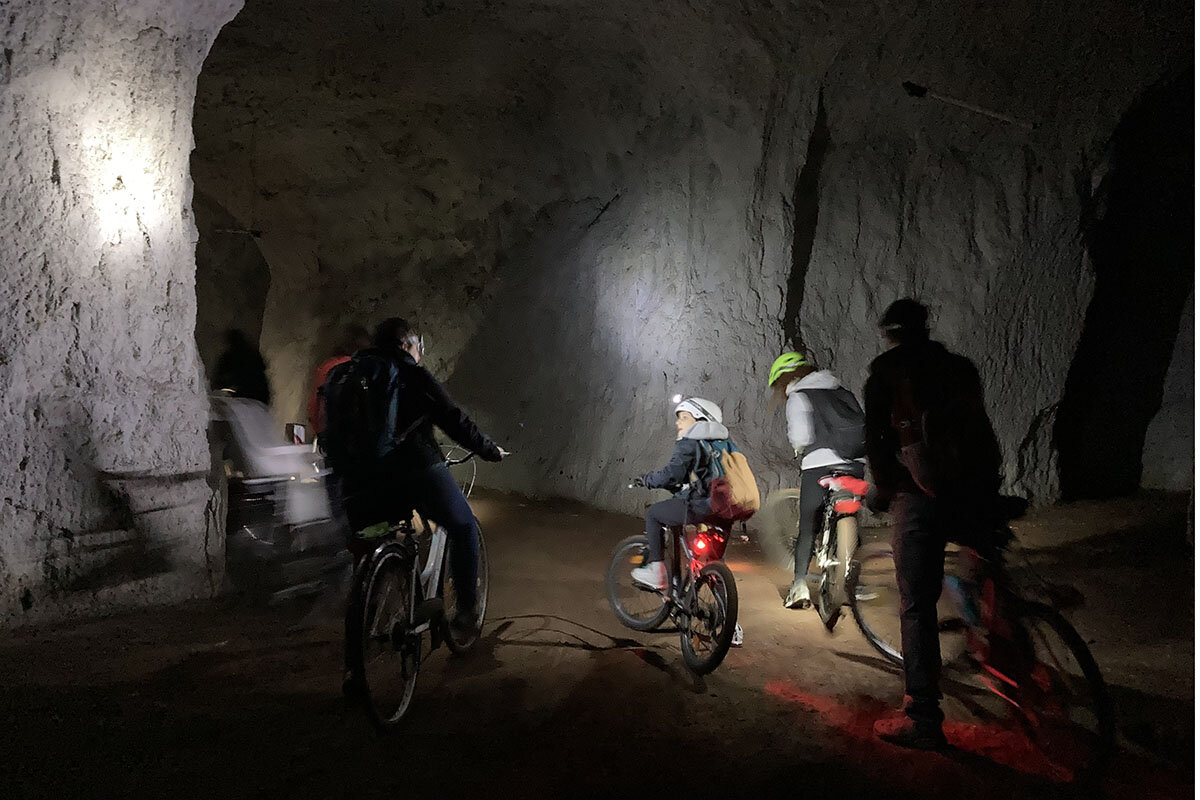Rome in the dark? Bike tours of buried quarry offer new view of city.
Loading...
| Rome
In a tract of countryside outside the ancient walls of Rome, amid verdant fields and hedgerows reminiscent of J.R.R. Tolkien’s The Shire, a mossy sunken lane overhung with alder trees leads down to a metal gate.
Beyond it is one of Rome’s largest but least known wonders: a labyrinth of tunnels that were hacked out of solid rock by the Romans 2,000 years ago. And this subterranean realm can now be explored by bicycle.
Guides have recently started taking small groups of visitors on bike tours of the Great Quarry of Rome, which holds 22 miles of twisting, underground passageways.
Why We Wrote This
Even the most popular tourist sites can still hold secrets. In the case of Rome, an underground bike tour offers a new perspective on the Eternal City and its history.
The labyrinth is well suited to two wheels – the tunnels are lined with hard-packed earth which forms a relatively flat surface to negotiate by bicycle. A mountain bike is ideal but even a city bike will do the job.
“It’s a pretty unusual experience, even for Rome,” says Luigi Plos, a guide with Sotterranei di Roma (Underground Places of Rome), a group of speleologists and historians who specialize in exploring the city’s subterranean places. “It is the only underground tour by bike in Rome.”
Biking in the dark
The Great Quarry of Rome, which is unknown to most Romans, lies beneath the Parco della Caffarella (Caffarella Park), a large wedge of countryside located just a few miles from the Colosseum, near the ancient Appian Way Roman road.
The origins of the quarry lie with the Romans’ quest for a much-prized building material. The area is rich with pozzolana, a volcanic rock which the Romans pulverized and mixed with lime to create a type of ancient concrete.
It was used in the construction of vast edifices such as the Pantheon temple and several huge baths complexes, including the Baths of Caracalla, located close to the Circus Maximus chariot-racing track of “Ben-Hur” fame.
“The reason the Romans dug this underground quarry so close to the city was because transportation was so expensive. Building materials are heavy and if you want to bring them from far away, you have to pay the workers, you need to feed the beasts of burden, [and] there is the danger of brigands. It was much cheaper to excavate right here, close to the city,” says Alessandro Placidi, another guide with Sotterranei di Roma.
The bike tours, which can include around 40 cyclists, travel through tunnels that were used to grow mushrooms as recently as the mid-1990s. Strands of electrical lighting dangle from the ceilings and sheets of translucent plastic are still attached to the walls – the sheets enabled the mushroom growers to create just the right temperature and humidity for the cultivation of fungi.
Visitors cycle past a chamber in which there is a long table and benches – it was the underground canteen of the mushroom growers. At one point, Mr. Placidi asks the tour group to turn off all bike lights and mobile phones. The darkness is absolute – not a single shape or shadow can be made out.
One section of the quarry was burrowed beneath a large catacomb that was dug by the early Christians to bury their dead. Holes have been hacked in the walls of the quarry to try to access the catacombs.
“It was the 1920s, and the mushroom growers who worked down here had heard of the amazing finds made by archeologists in ancient Egypt,” says Mr. Placidi, referring to the discovery of King Tutankhamen’s tomb by Howard Carter. “They thought there might be similar treasures waiting to be discovered in the catacombs. But they found nothing – just skeletons.”
Mushroom cultivation was abandoned in the 1990s, and the quarry was largely forgotten, until being opened to the public recently.
Beneath Claudius’ temple
Along with Sotterranei di Roma, the similarly named Roma Sotterranea (Underground Rome) is also trying to open up Rome’s many intriguing subterranean spaces to exploration. The two maintain a friendly rivalry.
This summer, Roma Sotterranea began taking visitors to another subterranean quarry, this one burrowed into a hill just a few minutes’ walk from the Roman Forum and the Colosseum.
The quarry, which is accessed by a tiny door, lies beneath the remains of a huge temple that was built in honor of Claudius, the emperor who invaded Britain in A.D. 43.
The extraction of stone began after the fall of the Roman Empire in the 5th century and continued for more than 1,000 years, until the 17th century. In places, workers dug beneath the water table, and some chambers now contain limpid pools of pure, crystalline water.
“To have underground pools and quarries just a few hundred meters from the Colosseum is an incredible thing,” says Marco Gradozzi, a Roma Sotterranea guide.







